An Evaluation of Eco-Environmental Quality Based on the Fused Remote Sensing Ecological Index (FRSEI) in the Jinjie Coal Mine Area, Northwest China
Abstract
1. Introduction
2. Materials and Methods
2.1. Study Area
2.2. Remotely Sensed Data
2.2.1. High-Resolution Data
2.2.2. Medium-Resolution Data
2.3. Methods
2.3.1. Greenness Index (NDVI)
2.3.2. Wetness Index
2.3.3. Land Surface Temperature (LST)
2.3.4. Normalized Differential Building–Soil Index (NDBSI)
2.3.5. Establishment of the Remote Sensing Ecological Index Evaluation Model
2.3.6. Verification of the FRSEI’s Calculation Results
3. Results
3.1. FRSEI Results of the Jinjie Mining Area
3.2. FRSEI Variation Trends of the Jinjie Mining Area
3.3. Robustness of the FRSEI’s Estimation Results
4. Discussion
4.1. The FRSEI Enhances the Spatial Resolution of the Remote Sensing Ecological Index
4.2. Impact of Human Activities on the Ecological Environment of the Jinjie Mining Area
5. Conclusions
Author Contributions
Funding
Data Availability Statement
Acknowledgments
Conflicts of Interest
References
- Wu, Z.; Wang, M.; Chen, S.; Zou, D. Monitoring and Evaluation of Ecological Environments Spatio-Temporal Variation in Mine Based on RSEI in Yongding Mine. Ecol. Sci. 2016, 35, 200–207. [Google Scholar]
- Hao, Y.; Zhang, Z.; Liao, H.; Wei, Y. China’s farewell to coal: A forecast of coal consumption through 2020. Energy Poliey 2015, 86, 444–455. [Google Scholar] [CrossRef]
- Yue, H.; Liu, Y.; Zhu, R. Monitoring ecological environment change based on remote sensing ecological index in Shandong mining area. Bull. Soil Water Conserv. 2019, 39, 101–107. [Google Scholar]
- Lu, Y.; Heng, W.; Yue, H. Quantifying the coal mining impaction the ecological environment of Gobi open-pit mines. Sci. Total Environ. 2023, 883, 163723. [Google Scholar] [CrossRef]
- Li, D. Development Prospect of Photogrammetry and Remote Sensing. Geomat. Inf. Sci. Wuhan Univ. 2008, 33, 5–9. [Google Scholar]
- Yang, Y.; Erskine, P.; Lechner, A.; Mulligan, D.; Zhang, S.; Wang, Z. Detecting the Dynamics of Vegetation Disturbance and Recovery in Surface Mining Area via Landsat Imagery and Land Trendr Algorithm. J. Clean. Prod. 2018, 178, 353–362. [Google Scholar] [CrossRef]
- Li, N.; Yan, C.; Xie, J. Remote Sensing Monitoring Recent Rapid Increase of Coal Mining Activity of an Important Energy Base in Northern China, a Case Study of Mu Us Sandy Land. Resour. Conserv. Recycl. 2015, 94, 129–135. [Google Scholar] [CrossRef]
- Hu, X.; Xu, H. A new remote sensing index for assessing the spatial heterogeneity in urban ecological quality: A case from Fuzhou City, China. Ecol. Indic. 2018, 89, 11–21. [Google Scholar] [CrossRef]
- HJ/T192-2006; Environmental Protection Industry Standards of the People’s Republic of China. China Environmental Science Press Co., Ltd.: Beijing, China, 2006.
- Yao, Y.; Wang, S.; Zhou, Y.; Liu, R.; Han, X. The Application of Ecological Environment Index Model on the National Evaluation of Ecological Environment Quality. Remote Sens. Inf. 2012, 27, 93–98. [Google Scholar]
- Zhang, Y. The Western Coal Mining Area Ecological Environment Situation of Quantitative Evaluation. Shandong Coal Sci. Technol. 2016, 5, 207–208. [Google Scholar]
- Xu, H. A Remote Sensing Index for Assessment of Regional Ecological Changes. China Environ. Sci. 2013, 33, 889–897. [Google Scholar]
- Song, H.; Xue, L. Dynamie monitoring and analysis of ecological environment in Weinan City, Northwest China based on RSEI mode. J. Appl. Ecol. 2016, 27, 3913–3919. [Google Scholar]
- Liu, O.; Yu, F.; Mu, X. Evaluation of the ecological environment quality of the Kuye River source basin using the Remote Sensing ecological index. Int. J. Environ. Res. Public Health 2022, 19, 12500. [Google Scholar] [CrossRef] [PubMed]
- Xu, F.; Li, H.; Li, Y. Ecological environment quality evaluation and evolution analysis of a rare earth mining area under different disturbance conditions. Environ. Geochem. Health 2022, 43, 2243–2256. [Google Scholar] [CrossRef]
- Song, M.; Luo, Y.; Duan, L. Evaluation of Ecological Environment in the Xilin Gol Steppe Based on Modified Remote Sensing Ecological Index Model. Arid Zone Res. 2019, 36, 1521–1527. [Google Scholar]
- Xia, N. Study on Remote Sensing Monitoring of Eco-Environment and Assessment Model of Ecological Quality in Zhundong Mining Region. Ph.D. Thesis, Xinjiang University, Urumuqi, China, 2018. [Google Scholar]
- Wang, X. Study on Eco-Environmental Cumulative Effects in Coal Mining Area: Case Studies in Lu’an Mining Area. Ph.D. Thesis, China University of Mining and Technology, Xuzhou, China, 2010. [Google Scholar]
- Li, J.; Pei, Y.; Zhao, S.; Xiao, R.; Sang, X.; Zhang, C. A Review of Remote Sensing for Environmental Monitoring in China. Remote Sens. 2020, 12, 1130. [Google Scholar] [CrossRef]
- Li, N.; Wang, J.; Fen, Q. The improvement of ecological environment index model RSEI. Arab. J. Geosci. 2020, 13, 403. [Google Scholar]
- Ji, X.; Yan, Y.; Guo, W.; Teng, Y.; Zhao, C. Ecological environment assessment of Shanxi Province and planned mining area based on coupling Remote Sensing Ecological Index (RSEI) model. Coal Geol. Explor. 2023, 51, 103–112. [Google Scholar]
- Xu, H.; Wang, Y.; Guan, H.; Shi, T.; Hu, X. Detecting Ecological Changes with a Remote Sensing Based Ecological Index (RSEI) Produced Time Series and Change Vector Analysis. Remote Sens. 2019, 11, 2345. [Google Scholar] [CrossRef]
- Lan, G.; Jiang, X.; Xu, D.; Guo, X.; Wu, Y.; Liu, Y.; Yang, Y. Ecological vulnerability assessment based on remote sensing ecological index (RSEI): A case of Zhongxian County, Chongqing. Front. Environ. Sci. 2023, 10, 1074376. [Google Scholar] [CrossRef]
- Jiang, F.; Zhang, Y.; Li, J.; Sun, Z. Research on remote sensing ecological environmental assessment method optimized by regional scale. Environ. Sci. Pollut. Res. 2021, 28, 68174–68187. [Google Scholar] [CrossRef] [PubMed]
- Zhu, D.; Chen, T.; Niu, R.; Zhen, N. Analyzing the Ecological Environment of Mining Area by Using Moving Window Remote Sensing Ecological Index. Geomat. Inf. Sci. Wuhan Univ. 2021, 46, 341–347. [Google Scholar]
- Zheng, Z.; Wu, Z.; Chen, Y.; Guo, C. Francesco Marinello, Instability of remote sensing based ecological index (RSEI) and its improvement for time series analysis. Sci. Total Environ. 2022, 814, 152595. [Google Scholar] [CrossRef] [PubMed]
- Fan, Y.; Liu, Y.; Heng, W.; Yue, H.; Bi, Y. lmpaet analysis of coal mining on ecological environment in Shandong Mining area from 1990 to 2022 based on RSEI. J. Green Mine 2024, 2, 41–53. [Google Scholar]
- Li, X.; Zheng, Y.; Chen, A.; Zhou, J.; Li, Q.; Hou, Q. Ldentilicaion of ecological restoration priority areas based on ecological security patems and risk assessment: A case study of Shenmu City. Acta Ecol. Sin. 2024, 44, 8784–8797. [Google Scholar]
- Yang, P.; Yang, W.; Ma, R. Study on microscopic pore sruclure types of Jurassic sandstone and water abundance in Jinjie Coal Mine. Coal Sci. Technol. 2021, 49, 188–194. [Google Scholar] [CrossRef]
- Zhao, J.; Meng, L.; Wang, Q.; Guo, D.; Shen, Z. Development and Construction of China’s High-Resolution Earth Observation System. Satell. Appl. 2022, 11, 8–13. [Google Scholar]
- Liu, H.; Han, Y.; Wang, W.; Zhang, P.; Yao, R.; Zhao, W. Promoting the Synergistic Development of a New Round of Strategic Actions for Mineral Exploration Breakthroughs and Ecological Protection—AI + Geological Information Construction on the Qinghai-Tibet Plateau. Technol. Innov. Appl. 2024, 14, 91–93+98. [Google Scholar] [CrossRef]
- Duan, J. Comparative Analysis of Land Surface Temperature Retrieval Algorithms Based on Landsat8 Data: A Case Study of Beijing. Anhui Agric. Sci. Bull. 2019, 25, 148–150. [Google Scholar]
- Xu, H.; Duan, W.; Deng, W.; Lin, M. RSEI or MRSEI? Comment on Jia et al. Evaluation of Eco-Environmental Quality in Qaidam Basin Based on the Ecological Index (MRSEI) and GEE. Remote Sens. 2021, 13, 4543. Remote Sens. 2022, 14, 5307. [Google Scholar] [CrossRef]
- Wang, L.; Jiao, L.; Lai, F.; Zhang, N. Evaluation of ecological changes based on remote sensing ecological index in Manas Lake wetland, Xinjiang. Acta Ecol. Sin. 2019, 39, 2963–2972. [Google Scholar]
- Chao, F.; Feng, G.; Wang, L.; Zhao, S. Evaluation of Environmental Quality Based on Remote Sensing Data in the Coastal Lands of Eastern China. J. Coast. Res. 2010, 36, 1229–1236. [Google Scholar]
- Zhou, J.; Liu, W. Monitoring and Evaluation of Eco-Environment Quality Based on Remote Sensing-Based Ecological Index (RSEI) in Taihu Lake Basin, China. Sustainability 2022, 14, 5642. [Google Scholar] [CrossRef]
- Gao, B. NDWI—A normalized difference water index for remote sensing of vegetation liquid water from space. Remote Sens. Environ. 1996, 58, 257–266. [Google Scholar] [CrossRef]
- Wilson, E.H.; Sader, S.A. Detection of forest harvest type using multiple dates of Landsat TM imagery. Remote Sens. Environ. 2002, 80, 385–396. [Google Scholar] [CrossRef]
- Liu, X.; Zhou, J.; Lu, J.; Jia, L.; Xiong, X.; Cui, Y. Analyzing the uncertainty of the multisource remote sensing-based vegetation products for drought monitoring. Natl. Remote Sens. Bull. 2024, 28, 2383–2404. [Google Scholar] [CrossRef]
- Crist, E.P. A TM tasseled cap equivalent transformation for reflectance factor data. Remote Sens. Environ. 1985, 17, 301–306. [Google Scholar] [CrossRef]
- Huang, C.; Wylie, B.; Yang, L.; Homer, C.; Zylstra, G. Derivation of a tasseled cap transformation based on Landsat 7 at satellite reflectance. Int. J. Remote Sens. 2002, 23, 1741–1748. [Google Scholar] [CrossRef]
- Chen, C.; Fu, J.; Zhang, S.; Zhao, X. Coastline information extraction based on the tasseled cap transformation of Landsat-8 OLI images. Estuar. Coast. Shelf Sci. 2019, 271, 281–291. [Google Scholar] [CrossRef]
- Li, Z.; Ma, Y. A study on retrieving land surface temperature of Menglun region in Xishuangbanna based on Landsat TM/ETM+ thermal band. J. Yunnan Univ. Nat. Sci. Ed. 2008, 30, 373–376. [Google Scholar]
- Qin, Z.; Zhang, M.; Karnieli, A.; Berliner, P. Mono-window Algorithm for retrieving land surface temperature form Landsat TM6 data. Acta Geogr. Sin. 2001, 56, 456–466. [Google Scholar]
- Jiménez-Muñoz, J.C.; Sobrino, J.A. A generalized single-channel method for retrieving land surface temperature from remote sensing data. J. Geophys. Res. Atmos. 2003, 108, 4688. [Google Scholar] [CrossRef]
- Qin, Z.; Li, W.; Xu, B.; Chen, Z.; Liu, J. The estimation of land surface emissivity for Landsat TM6. Remote Sens. Land Resour. 2004, 16, 28–32. [Google Scholar]
- Rikimaru, A.; Roy, P.S.; Miyatake, S. Tropical forest cover density mapping. Trop. Ecol. 2002, 43, 39–47. [Google Scholar]
- Wang, S.; Xu, H.; Tang, F. IBI and CA Model based extraction of urban built-up area and its application: A case study in Shanghai. Remote Sens. Technol. Appl. 2017, 32, 1161–1170. [Google Scholar]
- Liu, Z.; Xu, H.; Li, L.; Tang, F.; Lin, Z. Ecological changes in the Hangzhou area using the remote sensing based ecological index. J. Sci. Eng. 2015, 23, 728–739. [Google Scholar]
- Xu, N. Analysis of Changes in Vegetation Coverage in Tibet during 2005—2014 Based on Remote Sensing. J. Anhui Agri. Sci 2016, 44, 33–37. [Google Scholar]
- Liu, J.; Kuang, R.; Li, J.; Hu, M. Inversion Model of TN, TP Concentration Based on Measured Spectral Reflectance Data in Poyang Lake. Southwest China J. Agric. Sci. 2020, 9, 2088–2094. [Google Scholar]
- Li, P.; Gao, X. The Impact of Photovoltaic Power Plants on Ecological Environment and Climate: A Literature Review. Plateau Meteorol. 2021, 40, 702–710. [Google Scholar]
- Ruan, Y. Extraction and feature analysis of vegetation phenology information from medium-high resolution remote sensing data. Acta Geod. Cartogr. Sin. 2023, 52, 1801. [Google Scholar]
- Chen, S.; Lu, D.; Wu, S. Quantitative Comparison of Normalized Water Body Index between GF-1 and Landsat 8 Remote Sensing Images in Karst Regions. J. Atmos. Environ. Opt. 2020, 15, 125–133. [Google Scholar]
- Xu, H.; Wang, M.; Shi, T.; Guan, H.; Fang, C.; Lin, Z. Prediction of ecological effects of potential population and impervious surface increases using a remote sensing based ecological index (RSEI). Ecol. Indic. 2018, 93, 730–740. [Google Scholar] [CrossRef]
- Zhai, M.; Xu, X.; Jang, D. Remote sensing monitoring of the ecologic environment in Wuhai Mining Area since 1979. Remote Sens. Technol. Appl. 2012, 27, 933–940. [Google Scholar]
- Adibee, N.; Osanloo, M.; Rahmanpour, M. Adverse effects and their of coal mine waste dumps on the environment management. Environ. Earth Sci. 2013, 70, 1581–1592. [Google Scholar] [CrossRef]
- Liu, Y.; Wei, J.; Bi, Y.; Yue, H.; He, X. Evaluation of ecosystem service function in Shandong Mining Area. J. China Coal Soc. 2021, 46, 1599–1613. [Google Scholar]
- Yuan, W.; Shen, D. Coal Group: Enhancing political position, loyally fulfilling duties and fulfilling responsibilities. China Coal Ind. 2021, 6, 18–19. [Google Scholar]
- Niu, H.; Tian, S.; Zu, P.; Cao, M.; Qu, S.; Dong, Q.; Li, B.; Jiang, Z.; Bi, Y.; Yue, H. Effect of coal mining on net primary productivity of vegetation in Shan-dong Mining Area. Coal Sci. Technol. 2024, 52, 267–277. [Google Scholar]
- Zhao, X. Yulin will construct a 400-kilometer photovoltaic industrial belt. Mod. Enterp. 2013, 10, I0001. [Google Scholar]
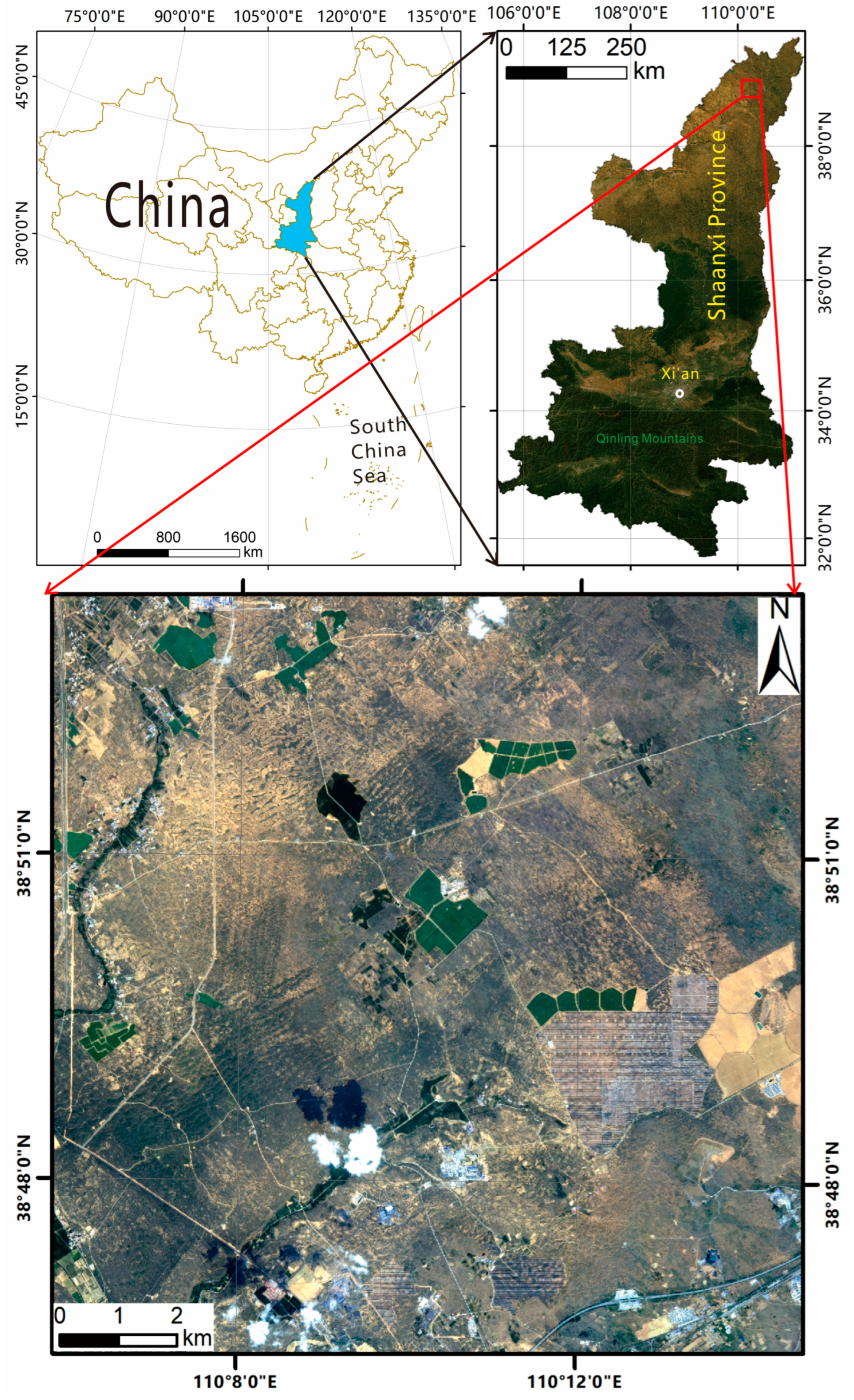


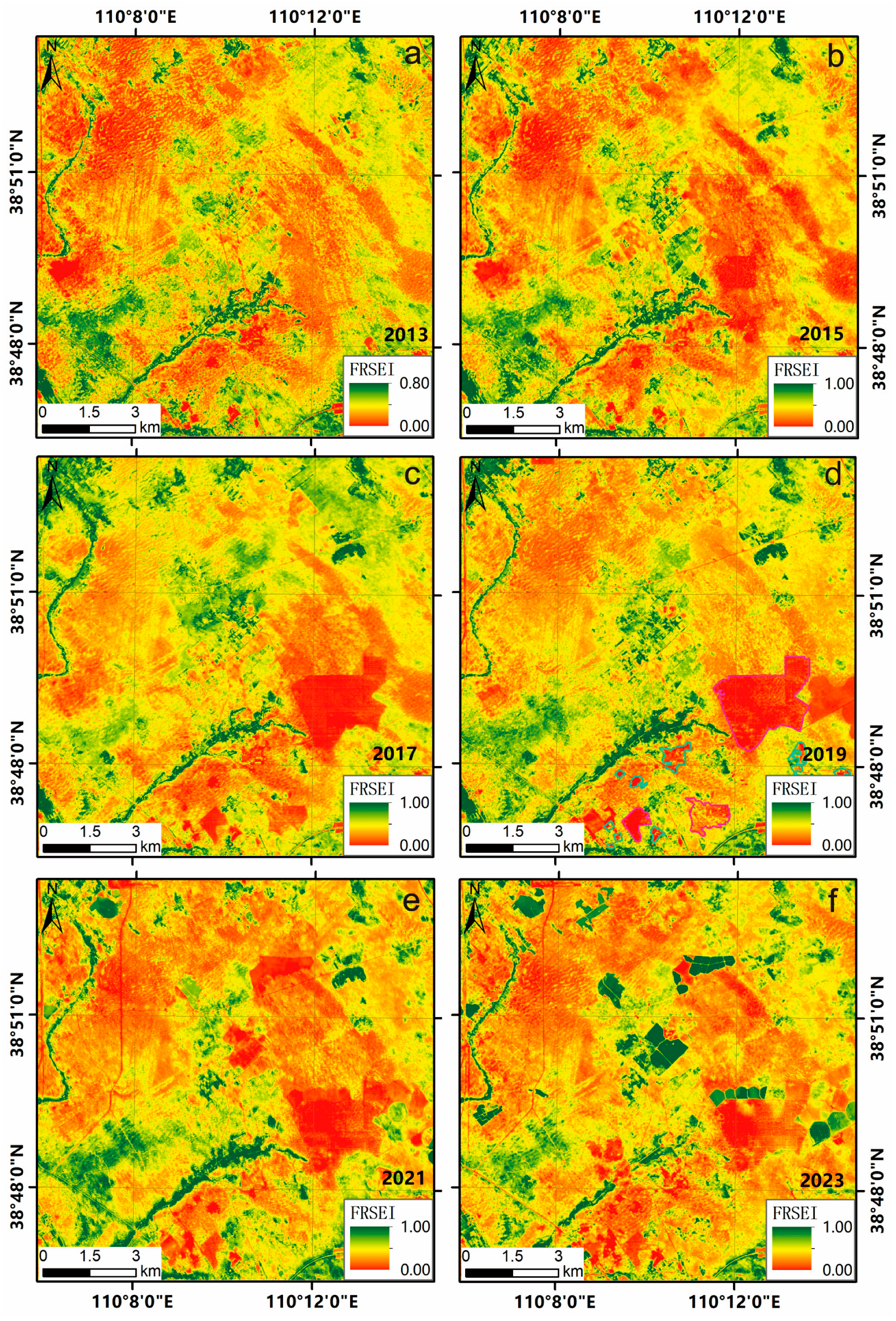
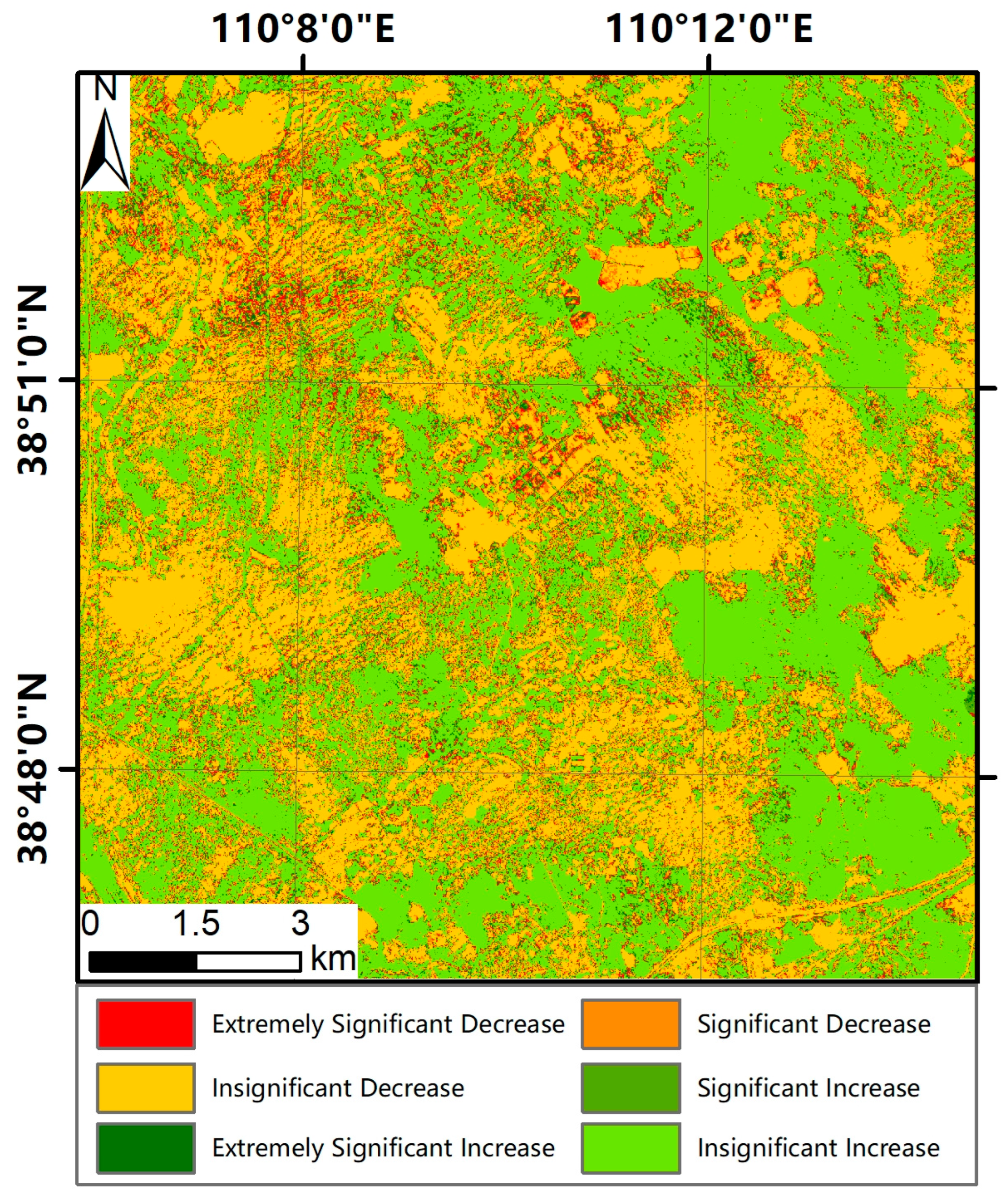

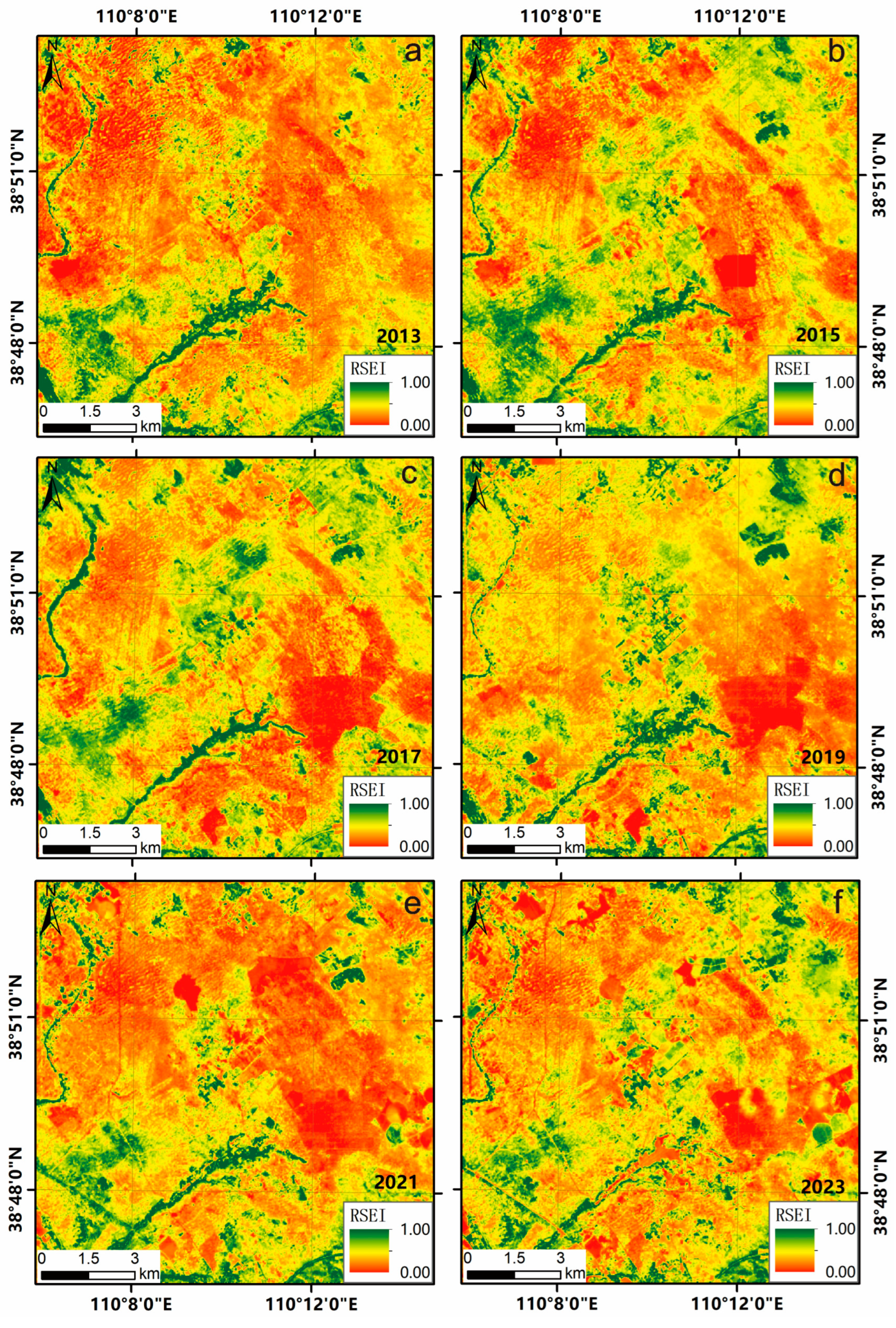
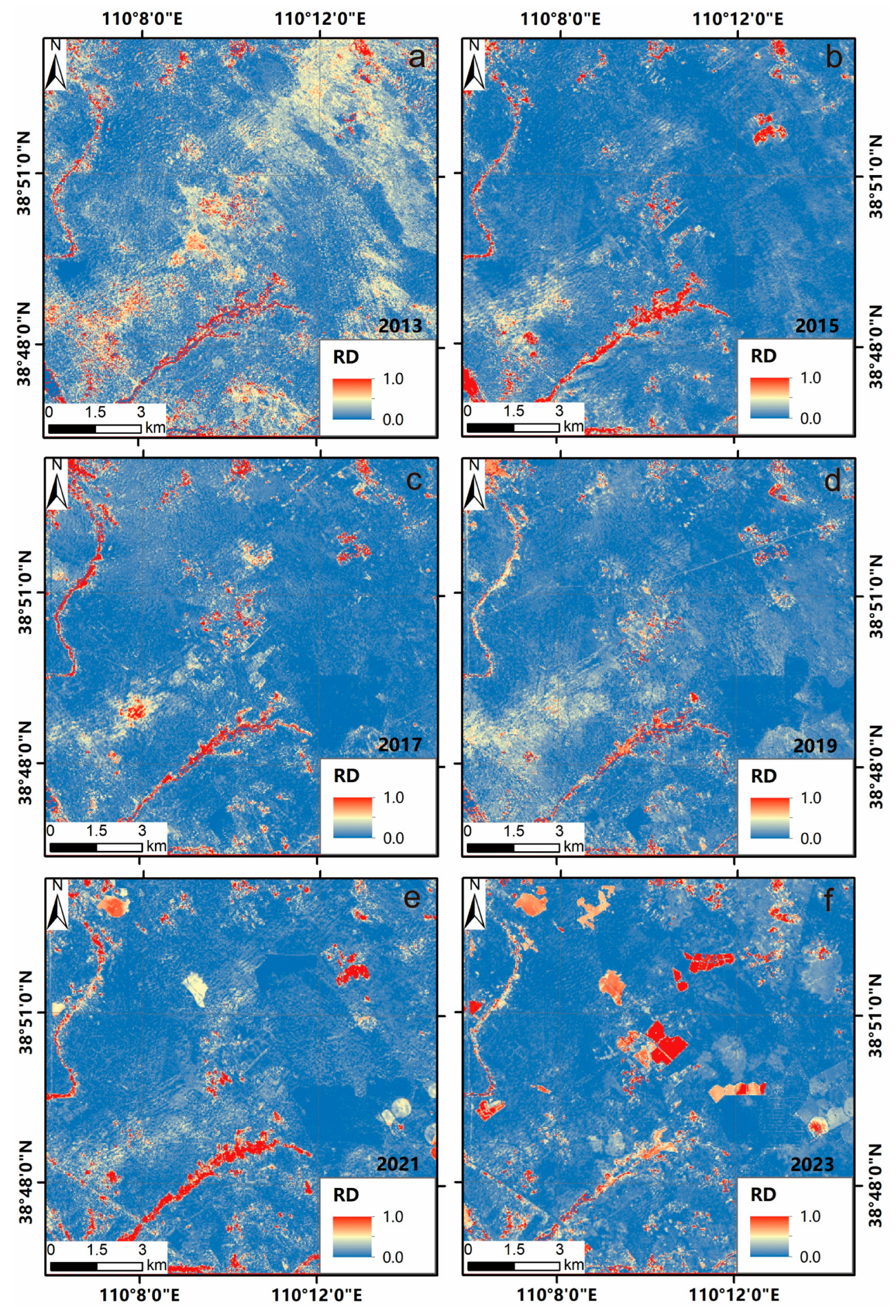
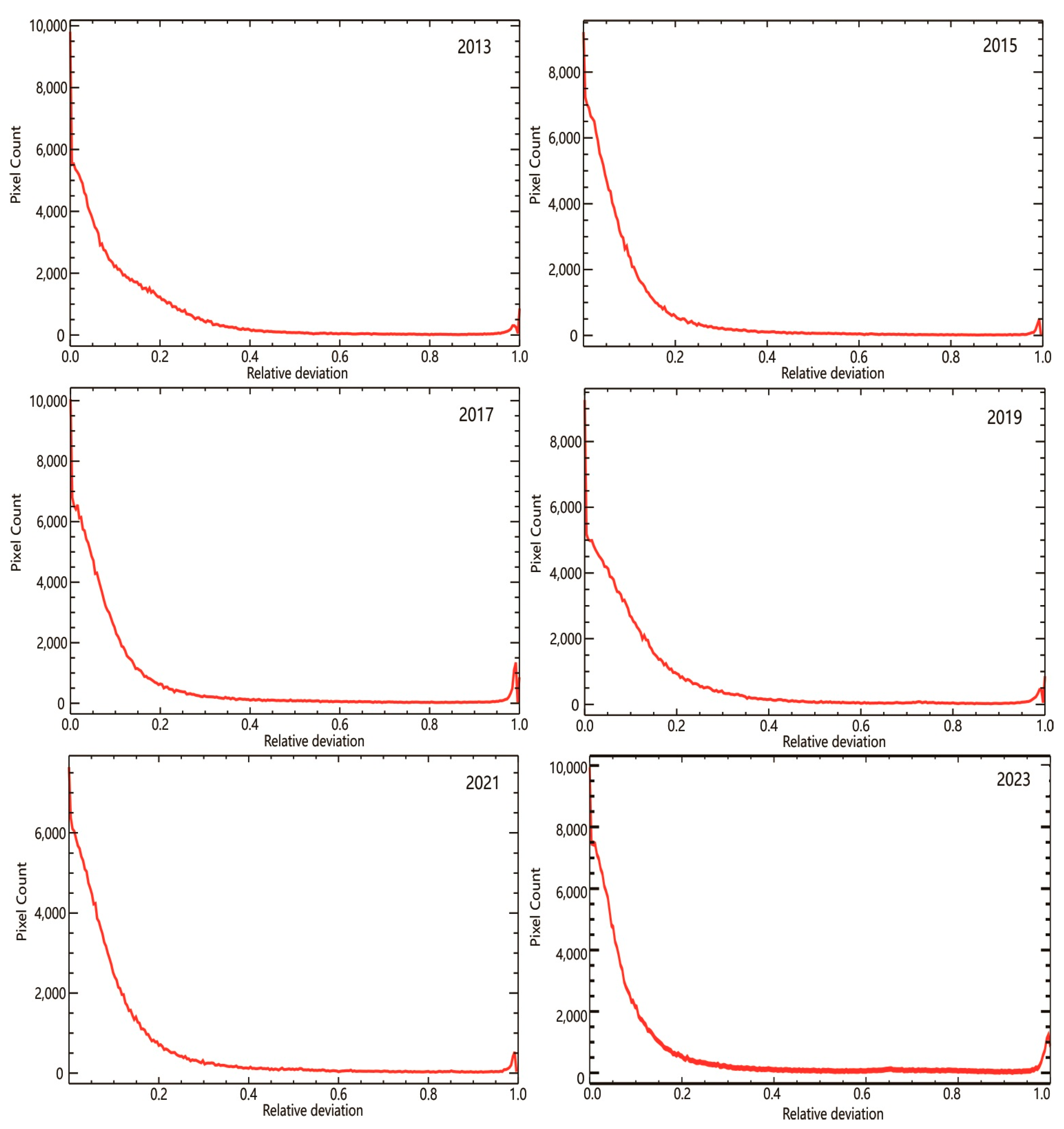
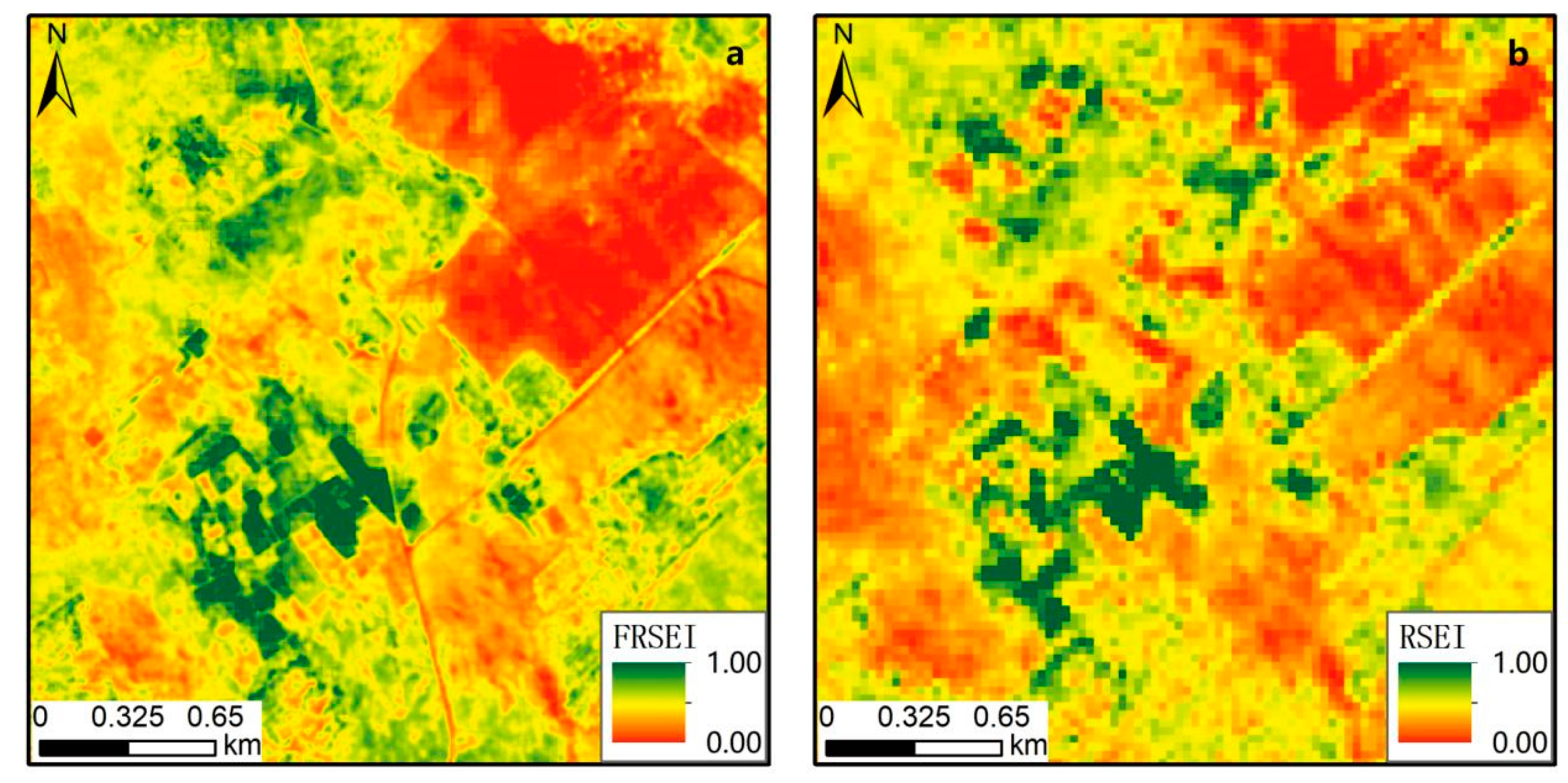
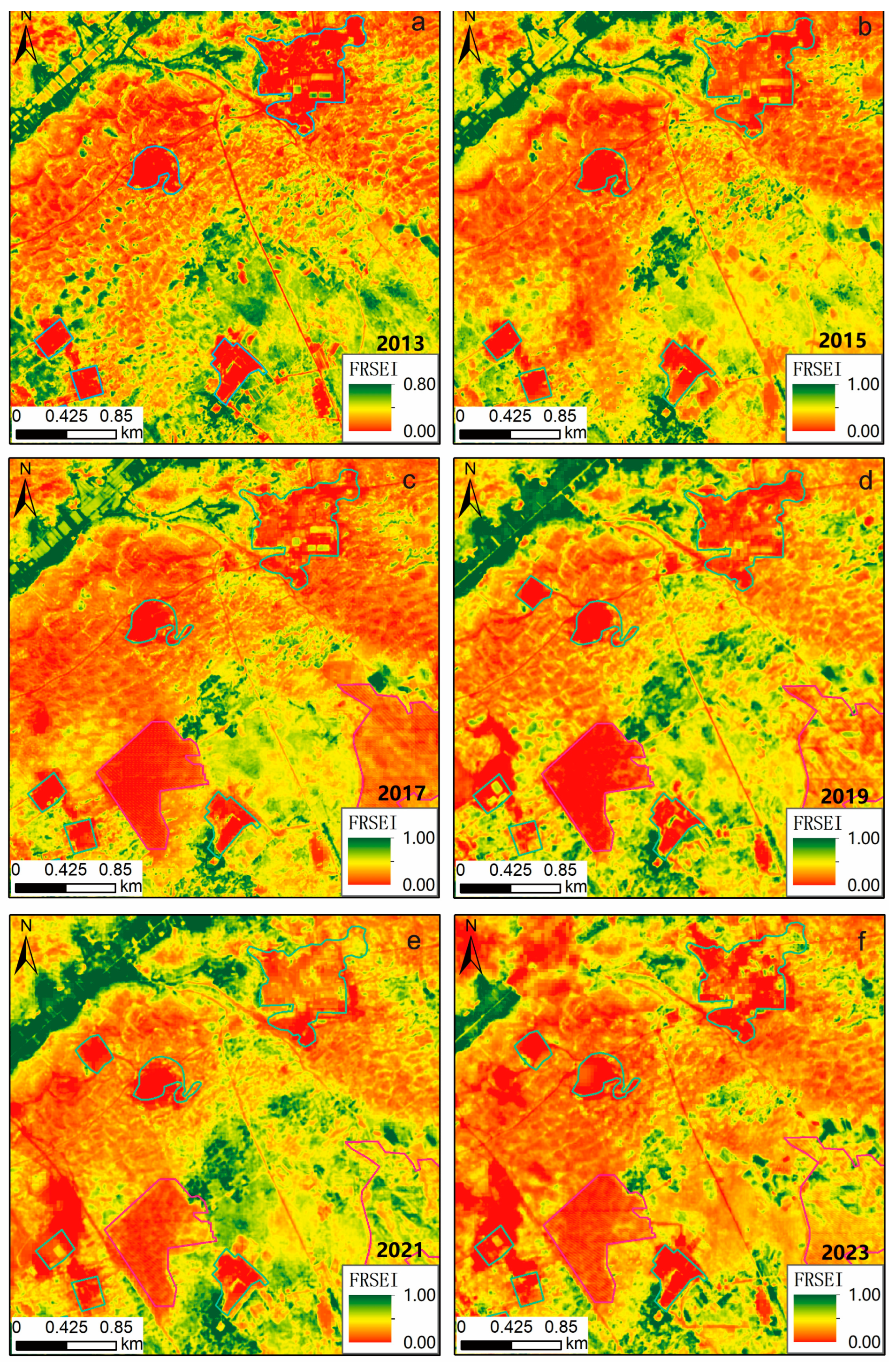
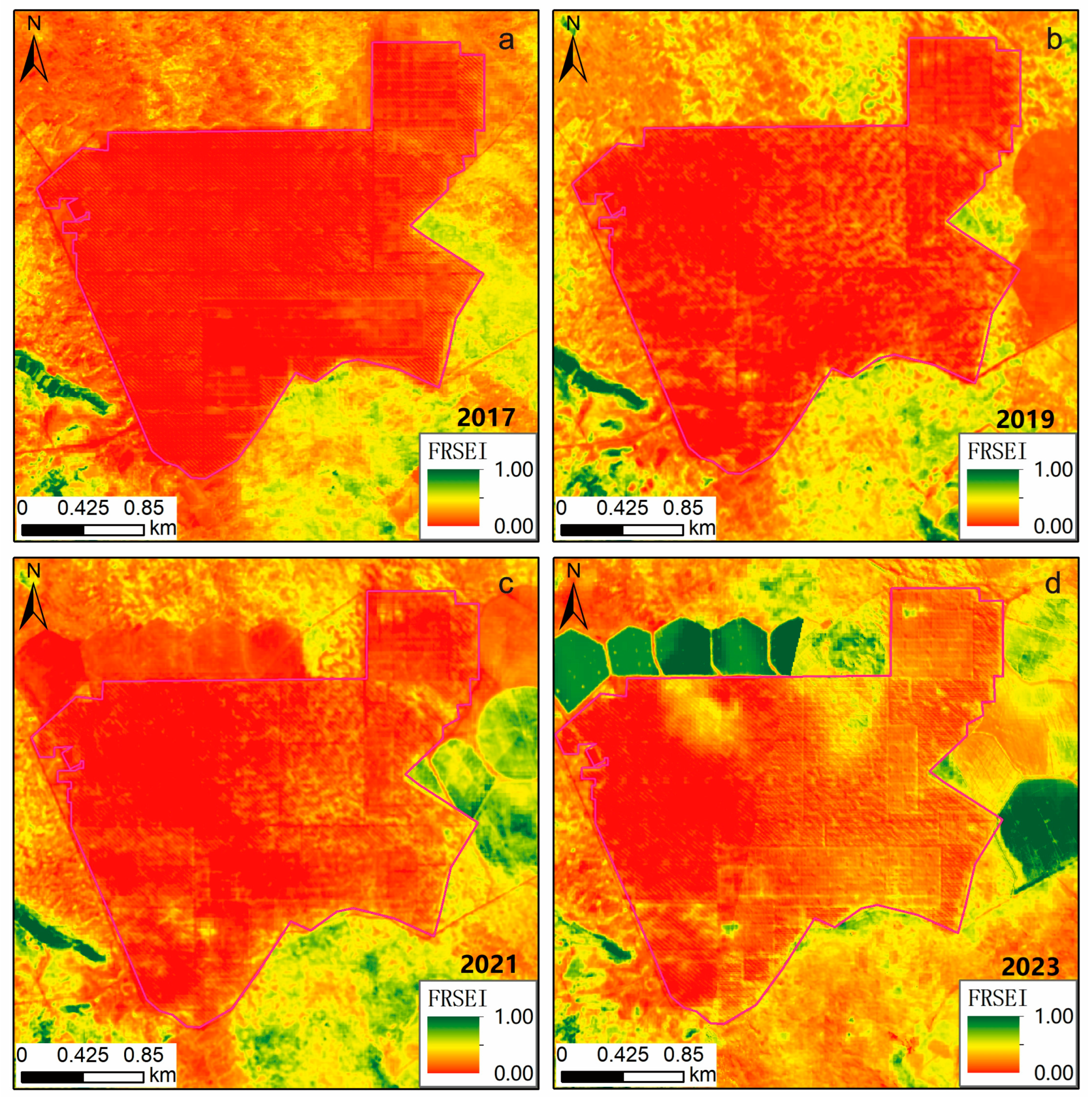
| No. | Satellite | Spatial Resolution (m) | Acquisition Time (Year. Month. Day) | Bands |
|---|---|---|---|---|
| 1 | GF1 | 2.0 | 2013.09.24 | 4 |
| 2 | GF1 | 2.0 | 2015.05.12 | 4 |
| 3 | GF1 | 2.0 | 2017.08.03 | 4 |
| 4 | GF1 | 2.0 | 2019.08.07 | 4 |
| 5 | GF1 | 2.0 | 2021.07.04 | 4 |
| 6 | GF1 | 2.0 | 2023.07.18 | 4 |
| 7 | Landsat 8 OLI | 30.0 | 2013.06.19 | 8 |
| 8 | Landsat 8 OLI | 30.0 | 2015.09.05 | 8 |
| 9 | Landsat 8 OLI | 30.0 | 2017.09.08 | 8 |
| 10 | Landsat 8 OLI | 30.0 | 2019.05.25 | 8 |
| 11 | Landsat 8 OLI | 30.0 | 2021.05.30 | 8 |
| 12 | Landsat 8 OLI | 30.0 | 2023.06.05 | 8 |
| Basis for Classification | Levels |
|---|---|
| Slope < 0, p ≤ 0.01 | Extremely significant decrease |
| Slope < 0, 0.01 < p ≤ 0.05 | Significant decrease |
| Slope < 0, p > 0.05 | Insignificant decrease |
| Slope > 0, p > 0.05 | Insignificant increase |
| Slope > 0, 0.01 < p ≤ 0.05 | Significant increase |
| Slope > 0, p ≤ 0.01 | Extremely significant increase |
| Minimum | Maximum | Mean | |
|---|---|---|---|
| 2013 | 0.00 | 1.00 | 0.5837 |
| 2015 | 0.00 | 1.00 | 0.6207 |
| 2017 | 0.00 | 1.00 | 0.5700 |
| 2019 | 0.00 | 1.00 | 0.5785 |
| 2021 | 0.00 | 1.00 | 0.6029 |
| 2023 | 0.00 | 1.00 | 0.6252 |
Disclaimer/Publisher’s Note: The statements, opinions and data contained in all publications are solely those of the individual author(s) and contributor(s) and not of MDPI and/or the editor(s). MDPI and/or the editor(s) disclaim responsibility for any injury to people or property resulting from any ideas, methods, instructions or products referred to in the content. |
© 2025 by the authors. Licensee MDPI, Basel, Switzerland. This article is an open access article distributed under the terms and conditions of the Creative Commons Attribution (CC BY) license (https://creativecommons.org/licenses/by/4.0/).
Share and Cite
Cui, X.; Gu, X.; You, X.; Wang, X.; Zhang, X.; Yang, M. An Evaluation of Eco-Environmental Quality Based on the Fused Remote Sensing Ecological Index (FRSEI) in the Jinjie Coal Mine Area, Northwest China. Water 2025, 17, 223. https://doi.org/10.3390/w17020223
Cui X, Gu X, You X, Wang X, Zhang X, Yang M. An Evaluation of Eco-Environmental Quality Based on the Fused Remote Sensing Ecological Index (FRSEI) in the Jinjie Coal Mine Area, Northwest China. Water. 2025; 17(2):223. https://doi.org/10.3390/w17020223
Chicago/Turabian StyleCui, Xudong, Xiaofan Gu, Xiangzhi You, Xiaoya Wang, Xin Zhang, and Min Yang. 2025. "An Evaluation of Eco-Environmental Quality Based on the Fused Remote Sensing Ecological Index (FRSEI) in the Jinjie Coal Mine Area, Northwest China" Water 17, no. 2: 223. https://doi.org/10.3390/w17020223
APA StyleCui, X., Gu, X., You, X., Wang, X., Zhang, X., & Yang, M. (2025). An Evaluation of Eco-Environmental Quality Based on the Fused Remote Sensing Ecological Index (FRSEI) in the Jinjie Coal Mine Area, Northwest China. Water, 17(2), 223. https://doi.org/10.3390/w17020223






